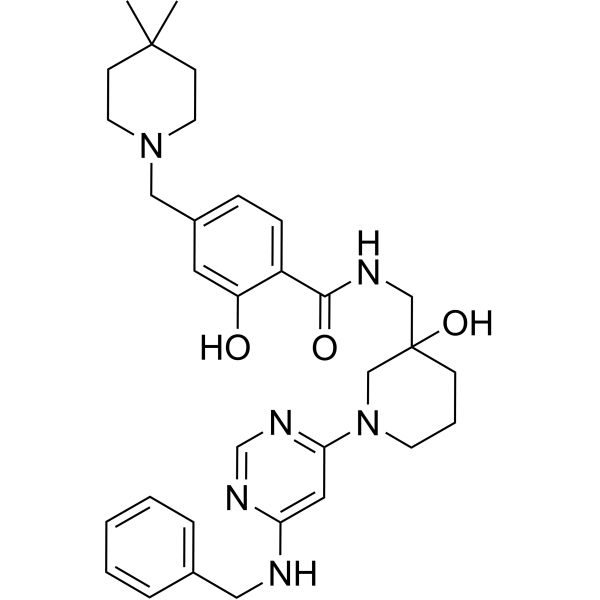Physicochemical Properties
| CAS # | 2925713-02-4 |
| Related CAS # | UZH1a;2813577-78-3;UZH1b;2814392-17-9 |
| Appearance | Off-white to light brown solid powder |
| HS Tariff Code | 2934.99.9001 |
| Storage |
Powder-20°C 3 years 4°C 2 years In solvent -80°C 6 months -20°C 1 month |
| Shipping Condition | Room temperature (This product is stable at ambient temperature for a few days during ordinary shipping and time spent in Customs) |
Biological Activity
| ln Vitro | UZH1 a (2.5-160 μM; 72 h) suppresses the development of U2Os, HEK293T, and MOLM-13 cells with IC50 values of 11 μM, 67 μM, and 87 μM, respectively [1]. MOLM-13, HEK293T, and U2Os cells are inhibited in growth by UZH1 b (2.5-160 μM; 72 h), with IC50 values of 78 μM, 79 μM, and 93 μM [1]. In MOLM-13 cells, UZH1 b is less active at concentrations up to 100 μM, while UZH1 a (2.5-100 μM; 16 hours) decreases m6A methylation levels in cellular mRNA in a dose-dependent manner (IC50=4.6 μM). Low [1]. The m6A methylation levels in MOLM-13, HEK293T, and U2Os cell mRNA are decreased by UZH1 a (40 μM; 16 h) [1]. In MOLM-13 cells, UZH1a (20 μM; 16 hours) promotes apoptosis and induces cell cycle arrest [1]. |
| References |
[1]. METTL3 inhibitors for epitranscriptomic modulation of cellular processes. bioRxiv. 2020 Oct 13. |
Solubility Data
| Solubility (In Vitro) | DMSO : 125 mg/mL (223.73 mM) |
| Solubility (In Vivo) |
Solubility in Formulation 1: ≥ 5 mg/mL (8.95 mM) (saturation unknown) in 10% DMSO + 40% PEG300 + 5% Tween80 + 45% Saline (add these co-solvents sequentially from left to right, and one by one), clear solution. For example, if 1 mL of working solution is to be prepared, you can add 100 μL of 50.0 mg/mL clear DMSO stock solution to 400 μL PEG300 and mix evenly; then add 50 μL Tween-80 to the above solution and mix evenly; then add 450 μL normal saline to adjust the volume to 1 mL. Preparation of saline: Dissolve 0.9 g of sodium chloride in 100 mL ddH₂ O to obtain a clear solution. Solubility in Formulation 2: ≥ 5 mg/mL (8.95 mM) (saturation unknown) in 10% DMSO + 90% (20% SBE-β-CD in Saline) (add these co-solvents sequentially from left to right, and one by one), clear solution. For example, if 1 mL of working solution is to be prepared, you can add 100 μL of 50.0 mg/mL clear DMSO stock solution to 900 μL of 20% SBE-β-CD physiological saline solution and mix evenly. Preparation of 20% SBE-β-CD in Saline (4°C,1 week): Dissolve 2 g SBE-β-CD in 10 mL saline to obtain a clear solution. Solubility in Formulation 3: ≥ 5 mg/mL (8.95 mM) (saturation unknown) in 10% DMSO + 90% Corn Oil (add these co-solvents sequentially from left to right, and one by one), clear solution. For example, if 1 mL of working solution is to be prepared, you can add 100 μL of 50.0 mg/mL clear DMSO stock solution to 900 μL of corn oil and mix evenly. (Please use freshly prepared in vivo formulations for optimal results.) |
